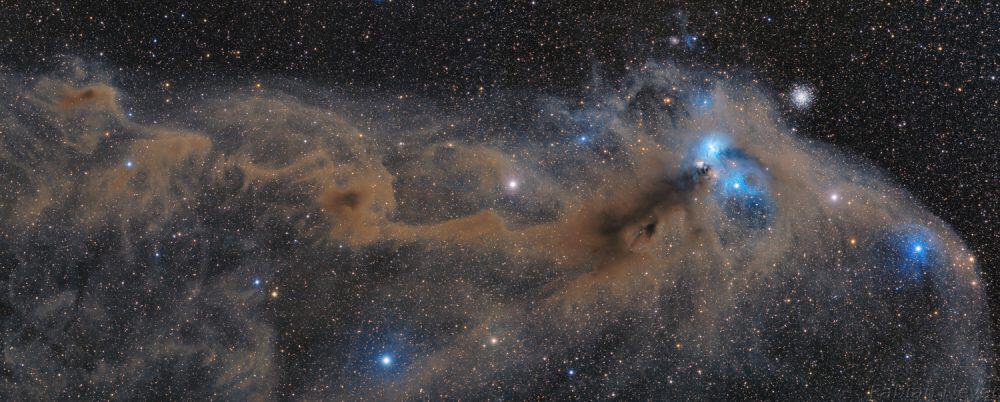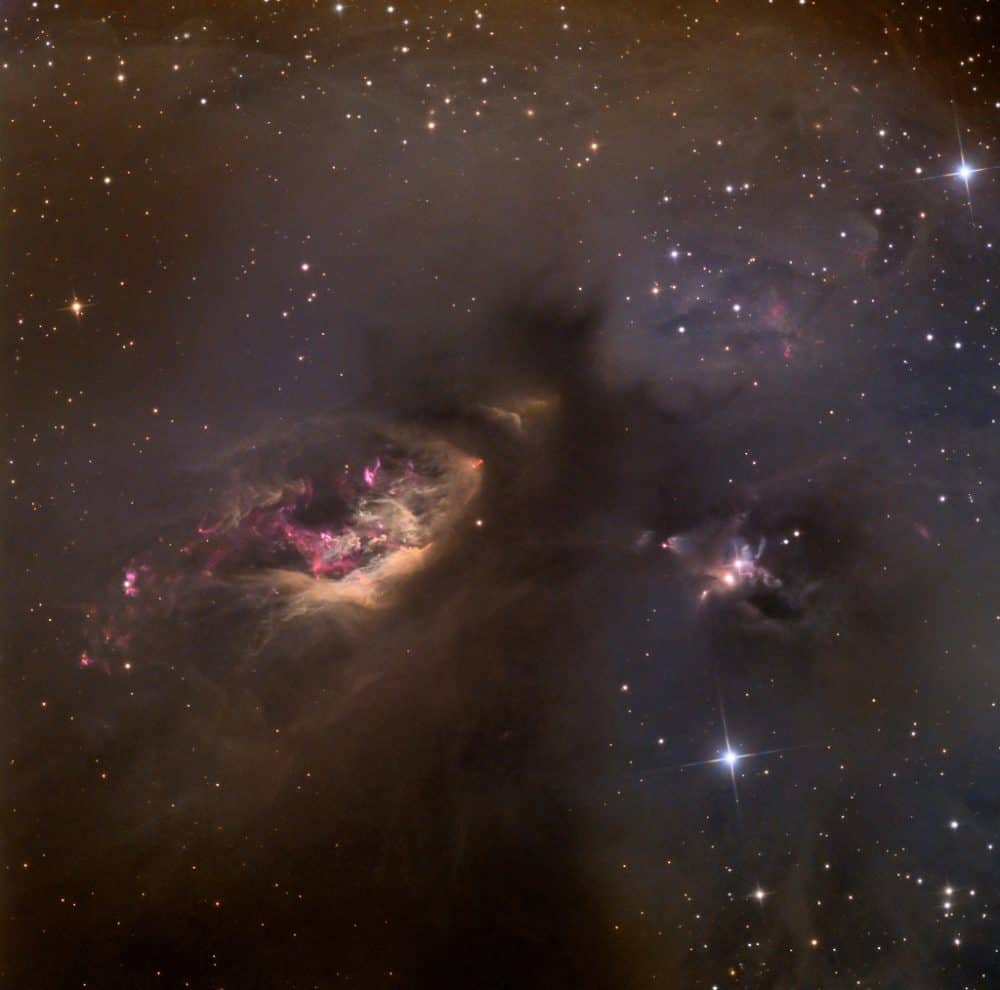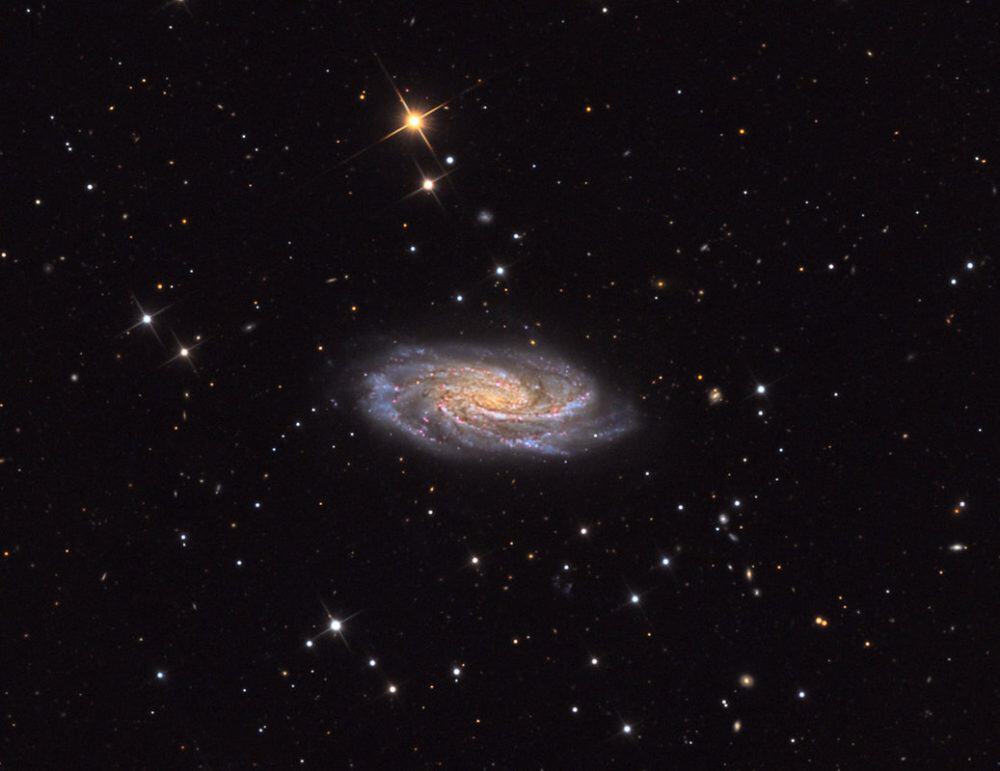Blog
Cosmic dust clouds are draped across a rich field of stars in this broad telescopic panorama near the northern boundary of Corona Australis, the Southern Crown. Less than 500 light-years away the denser clouds effectively block light from more distant background stars in the Milky Way. The entire vista spans about 5 degrees or nearly 45 light-years at the clouds’ estimated distance. Toward the right lies a group of bluish reflection nebulae cataloged as NGC 6726, 6727, 6729 and IC 4812. The characteristic blue color is produced as light from hot stars is reflected by the cosmic dust. The dust also obscures from view stars in the region still in the process of formation. Smaller yellowish nebula NGC 6729 surrounds young variable star R Coronae Australis. Below it are arcs and loops identified as Herbig Haro (HH) objects associated with energetic newborn stars. Magnificent globular star cluster NGC 6723 is above and right of the nebulae. Though NGC 6723 appears to be part of the group, its ancient stars actually lie nearly 30,000 light-years away, far beyond the young stars of the Corona Australis dust clouds.
more...Billy Hart (born November 29, 1940) is an American jazz drummer and educator.
Hart was born in Washington, D.C., where early on in his career he performed with soul artists such as Otis Redding and Sam and Dave, and then later with Buck Hill and Shirley Horn, and was a sideman with the Montgomery Brothers (1961), Jimmy Smith (1964–1966), and Wes Montgomery(1966–68). Following Montgomery’s death in 1968, Hart moved to New York, where he recorded with McCoy Tyner, Wayne Shorter, and Joe Zawinul, and played with Eddie Harris, Pharoah Sanders, and Marian McPartland.
Hart was a member of Herbie Hancock‘s sextet (1969–73), and played with McCoy Tyner (1973–74), Stan Getz (1974–77), and Quest (1980s), in addition to extensive freelance playing (including recording with Miles Davis on 1972’s On the Corner).
Since the early 1990s, Hart has been associated with Oberlin Conservatory of Music, and is also adjunct faculty at the New England Conservatory of Music and Western Michigan University. He also conducts private lessons through the New School and New York University. The drummer often contributes to the Stokes Forest Music Camp and the Dworp Summer Jazz Clinic in Belgium.
He has led a group with Mark Turner, Ethan Iverson, and Ben Street, is featured in a trio led by pianist Jean-Michel Pilc, another led by guitarist Assaf Kehati, and has performed in a band known as the Cookers, with Eddie Henderson, David Weiss, Craig Handy, George Cables and Cecil McBee, all who have toured extensively and recorded two CD.
more...John Mayall, OBE (born 29 November 1933) is an English blues singer, guitarist, organist and songwriter, whose musical career spans over sixty years. In the 1960s, he was the founder of John Mayall & the Bluesbreakers, a band which has counted among its members some of the most famous blues and blues rock musicians. They include Eric Clapton, Peter Green, Jack Bruce, John McVie, Mick Fleetwood, Mick Taylor, Don “Sugarcane” Harris, Harvey Mandel, Larry Taylor, Aynsley Dunbar, Hughie Flint, Jon Hiseman, Dick Heckstall-Smith, Andy Fraser, Johnny Almond, Walter Trout, Coco Montoya, Kal David, and Buddy Whittington.
more...William Thomas “Billy” Strayhorn (November 29, 1915 – May 31, 1967) was an American jazz composer, pianist, lyricist, and arranger, best remembered for his long-time collaboration with bandleader and composer Duke Ellington that lasted nearly three decades. His compositions include “Take the ‘A’ Train“, “Chelsea Bridge“, “A Flower Is a Lovesome Thing“, and “Lush Life“.
Strayhorn was born in Dayton, Ohio.
more...Brigada Victor Jara was formed in Coimbra, Portugal in 1974, following the April 25 revolution, in which traditional music had played an inspiring part. The band took its name from the Chilean folk singer murdered by the military after the Pinochet coup of 1973.
more...https://www.youtube.com/watch?v=Ml13OAEtNQw
more...This cosmic close-up looks deep inside the Soul Nebula. The dark and brooding dust clouds on the left, outlined by bright ridges of glowing gas, are cataloged as IC 1871. About 25 light-years across, the telescopic field of view spans only a small part of the much larger Heart and Soul nebulae. At an estimated distance of 6,500 light-years the star-forming complex lies within the Perseus spiral arm of our Milky Way Galaxy, seen in planet Earth’s skies toward the constellation Cassiopeia. An example of triggered star formation, the dense star-forming clouds of IC 1871 are themselves sculpted by the intense winds and radiation of the region’s massive young stars. The featured image appears mostly red due to the emission of a specific color of light emitted by excited hydrogen gas.
more...Randall Stuart Newman (born November 28, 1943 LA,CA) is an American singer-songwriter, arranger, composer, and pianist who is known for his distinctive voice, mordant (and often satirical) pop songs, and for film scores.
Since the 1980s, Newman has worked mostly as a film composer. His film scores include Ragtime, Awakenings, The Natural, Leatherheads, Cats Don’t Dance, Meet the Parents, Cold Turkey, and Seabiscuit. He has scored eight Disney–Pixar animated films: Toy Story, A Bug’s Life, Toy Story 2, Monsters, Inc., Cars, Toy Story 3, Monsters University, and Cars 3, as well as Disney’s The Princess and the Frog and James and the Giant Peach.
Newman has received twenty Academy Award nominations in the Best Original Score and Best Original Song categories and has won twice in the latter category. He has also won three Emmys, seven Grammy Awards, and the Governor’s Award from the Recording Academy.
Newman was inducted into the Songwriters Hall of Fame in 2002 for classics such as “Short People“, and as a Disney Legend in 2007. Newman was inducted to the Rock and Roll Hall of Fame in April 2013.
more...Leandro “Gato” Barbieri (28 November 1932 – 2 April 2016) was an Argentine jazz tenor saxophonist who rose to fame during the free jazz movement in the 1960s and is known for his Latin jazz recordings of the 1970s. His nickname, Gato, is Spanish for “cat”.
Born to a family of musicians, Barbieri began playing music after hearing Charlie Parker‘s “Now’s the Time”. He played the clarinet and later the alto saxophone while performing with the Argentinean pianist Lalo Schifrin in the late 1950s. By the early 1960s, while playing in Rome, he also worked with the trumpeter Don Cherry. By now influenced by John Coltrane‘s late recordings, as well as those from other free jazz saxophonists such as Albert Ayler and Pharoah Sanders, he began to develop the warm and gritty tone with which he is associated. In the late 1960s, he was fusing music from South America into his playing and contributed to multi-artist projects like Charlie Haden‘s Liberation Music Orchestra and Carla Bley‘s Escalator Over The Hill. His score for Bernardo Bertolucci‘s 1972 film Last Tango in Paris earned him a Grammy Award and led to a record deal with Impulse! Records
more...Roy McCurdy (born November 28, 1936) is a jazz drummer.
Before joining Cannonball Adderley‘s Quintet in 1965 and staying with the band until Adderley’s death in 1975, he had played with Chuck and Gap Mangione in the Jazz Brothers (1960–1961), as well as with Bobby Timmons, Betty Carter and Sonny Rollins (1963–1964), appearing on the classic 1963 album Sonny Meets Hawk!
He attended the Eastman School of Music from sixteen to eighteen, during which time he also played professionally with Roy Eldridge and with Eddie Vinson at seventeen. In 1960 he joined the Art Farmer – Benny Golson Jazztet and remained for two years.
Among the influences he cites Louie Bellson, Shelly Manne, Sam Woodyard, Buddy Rich, Papa Jo Jones, Philly Joe Jones and the bands of Duke Ellington, Jimmie Lunceford and Lionel Hampton.
He has also played and/or recorded with Count Basie, Wes Montgomery, Ella Fitzgerald, Sarah Vaughan, Carmen McRae, Joe Williams, Herbie Hancock, Oscar Peterson, Bud Powell, Art Pepper, and the jazz rock group Blood, Sweat and Tears, etc.
more...Gigi Gryce (born George General Grice Jr.; November 28, 1925 – March 14, 1983) was an American jazz saxophonist, flautist, clarinetist, composer, arranger, and educator.
While his performing career was relatively short, much of his work as a player, composer, and arranger was quite influential and well-recognized during his time. However, Gryce abruptly ended his jazz career in the 1960s. This, in addition to his nature as a very private person, has resulted in very little knowledge of Gryce today. Several of his compositions have been covered extensively (“Minority“, “Social Call”, “Nica’s Tempo”) and have become minor jazz standards. Gryce’s compositional bent includes harmonic choices similar to those of contemporaries Benny Golson, Tadd Dameron and Horace Silver. Gryce’s playing, arranging, and composing are most associated with the classic hard bop era (roughly 1953–1965). He was a well-educated composer and musician, and wrote some classical works as a student at the Boston Conservatory. As a jazz musician and composer he was very much influenced by the work of Charlie Parker and Thelonious Monk.
George General Grice Jr. was born in Pensacola, Florida on November 28, 1925
more...Portugal
more...This image shows Sharpless 239 (Sh2-239 or LBN 821, left), a reflection nebula surrounded by LDN 1551, a dark star forming cloud of gas and dust. The region stretches for nearly 3 light-years near the southern end of the Taurus molecular cloud, a region where active star formation is taking place, some 453 light-years away in the constellation of Taurus, near the border of the constellation Perseus.
LDN 1551 contains a total amount of material equivalent to about 50 times the mass of the Sun, and inside it you will find a dozen of pre-main sequence stars. Star formation activity has caused the mix of dust and colors in the nebulae.
Lots of embedded young stellar objects are spewing material in the surrounding interstellar medium, including (near the center of the image) a compact, red jet of shocked hydrogen gas near the position of the infrared source L1551 IRS 5, known to be a binary system of protostars surrounded by dust disks, separated by about 40 AU. Just below it are the broader, brighter wings of HH 102, one of the region’s many Herbig-Haro objects.
Herbig–Haro objects (HH) – after astronomers George Herbig and Guillermo Haro – are narrow jets of gas and matter ejected by young stars at speeds of 100 to 1000 kilometers per second that collide with the surrounding nebula, producing bright shock fronts that glow as the gas is heated by friction while the surrounding gas is excited by the high-energy radiation of nearby hot stars. They are ubiquitous in star-forming regions, and several are often seen around a single star. The stellar jets seem to form as the swirling cloud of dust and gas surrounding a new star escapes.
These objects are transient phenomena, lasting not more than a few thousand years. They can evolve visibly over quite short timescales as they move rapidly away from their parent star into the gas clouds in interstellar space.
The star formation in this area seems to proceed quickly as told by the rapid evaporation in the foreground. Soon even the deepest parts of this cloud will be blown away, and young clusters of stars will shine with exuberance.
more...James Marshall Hendrix (born Johnny Allen Hendrix; November 27, 1942 – September 18, 1970) was an American rock guitarist, singer, and songwriter. Although his mainstream career spanned only four years, he is widely regarded as one of the most influential electric guitarists in the history of popular music, and one of the most celebrated musicians of the 20th century. The Rock and Roll Hall of Fame describes him as “arguably the greatest instrumentalist in the history of rock music”.
Born in Seattle, Washington, Hendrix began playing guitar at the age of 15. In 1961, he enlisted in the U.S. Army and trained as a paratrooper in the 101st Airborne Division; he was granted an honorable discharge the following year. Soon afterward, he moved to Clarksville, Tennessee, and began playing gigs on the Chitlin’ Circuit, earning a place in the Isley Brothers‘ backing band and later with Little Richard, with whom he continued to work through mid-1965. He then played with Curtis Knight and the Squires before moving to England in late 1966 after being discovered by Linda Keith, who in turn interested bassist Chas Chandler of the Animals in becoming his first manager. Within months, Hendrix had earned three UK top ten hits with the Jimi Hendrix Experience: “Hey Joe“, “Purple Haze“, and “The Wind Cries Mary“. He achieved fame in the U.S. after his performance at the Monterey Pop Festival in 1967, and in 1968 his third and final studio album, Electric Ladyland, reached number one in the U.S.; it was Hendrix’s most commercially successful release and his first and only number one album. The world’s highest-paid performer, he headlined the Woodstock Festival in 1969 and the Isle of Wight Festival in 1970, before his accidental death from barbiturate-related asphyxia on September 18, 1970, at the age of 27.
https://www.youtube.com/watch?v=W3JsuWz4xWc
more...Lyle David Mays (born November 27, 1953) is an American jazz pianist and composer best known as a member of the Pat Metheny Group.Metheny and Mays composed and arranged nearly all of the group’s music, for which Mays has won eleven Grammy Awards.
Bill Evans‘ album Live in Montreux and Miles Davis‘ album Filles de Kilimanjaro were important influences on his formation as a jazz musician. He graduated from the University of North Texas after attending the University of Wisconsin-Eau Claire. He composed and arranged for the One O’Clock Lab Band and was the composer and arranger of Grammy-nominated album Lab 75.
After leaving North Texas, Mays toured with Woody Herman‘s group for approximately eight months. In 1974, he met Pat Metheny with whom he later founded the Pat Metheny Group. Mays has won eleven Grammy Awards with the Pat Metheny Group and has been nominated for four others for his own work.
In an interview with JAZZIZ magazine in 2016, Mays revealed his current career as a software manager.
In the Pat Metheny Group, Mays provides arrangements, orchestration, and the harmonic and metric backbone of the group’s musical signature. He occasionally performs on electric guitar as well. He played trumpet on the songs “Forward March” and “Yolanda You Learn” from the album First Circle (1984) and during the tour for that album
more...Randal Edward Brecker (born November 27, 1945) is an American trumpeter, flugelhornist, and composer. His versatility in different musical genres has made him a sought-after player, equally accomplished in playing jazz, rock, and R&B. He has also worked as a studio player for many famous musicians. He has performed or recorded with Stanley Turrentine, Billy Cobham, Larry Coryell, Bruce Springsteen, Lou Reed, Sandip Burman, Charles Mingus, Blood, Sweat & Tears, Horace Silver, Frank Zappa, Parliament-Funkadelic, Chris Parker, Jaco Pastorius, Eliane Elias, Dire Straits, Todd Rundgren, Blue Öyster Cult, Richard Barone, Spyro Gyra, Barbara Dennerlein and many others. In his formative years, Brecker studied trumpet with Bill Adam at Indiana University.
Danongan Kalanduyan was a master of all aspects of the Mindanao tribal style of kulintang music and an essential artistic figure in practically all major Filipino-American communities for several decades.
more...https://www.youtube.com/watch?v=Yy0SJco8wDg
more...NGC 3672 is a spiral galaxy of the Hubble type SA (s) c in the constellation Becher south of the celestial equator , which is estimated to be 100 million light-years away from the Milky Way .
The object was discovered by astronomer William Herschel on March 4, 1786 using its 18.7-inchtelescope and later recorded by Johan Dreyer in the New General Catalog .
more...More Posts
- Harvey Mandel Day
- Bobby McFerrin Day
- Astor Piazzolla Day
- Sonny Boy Williamson II
- World Music with Yelsy Heredia
- Daily Roots with Toots & the Maytals
- MOJO ROOTS Benefit Poster for Mayday 2020
- Kitty Kuluvar Memorial
- Happy Purim 2020
- The Cosmos with NGC 2264
- Ronnie Earl Day
- Don Abney Day
- Norman Blake Day
- Bix Beiderbecke Day
- World Music with Paco Martin
- Daily Roots with Willie Williams
- The Cosmos with NGC 4455
- Zakir Hussain Day
- Lloyd Price Day
- Ornette Coleman Day



